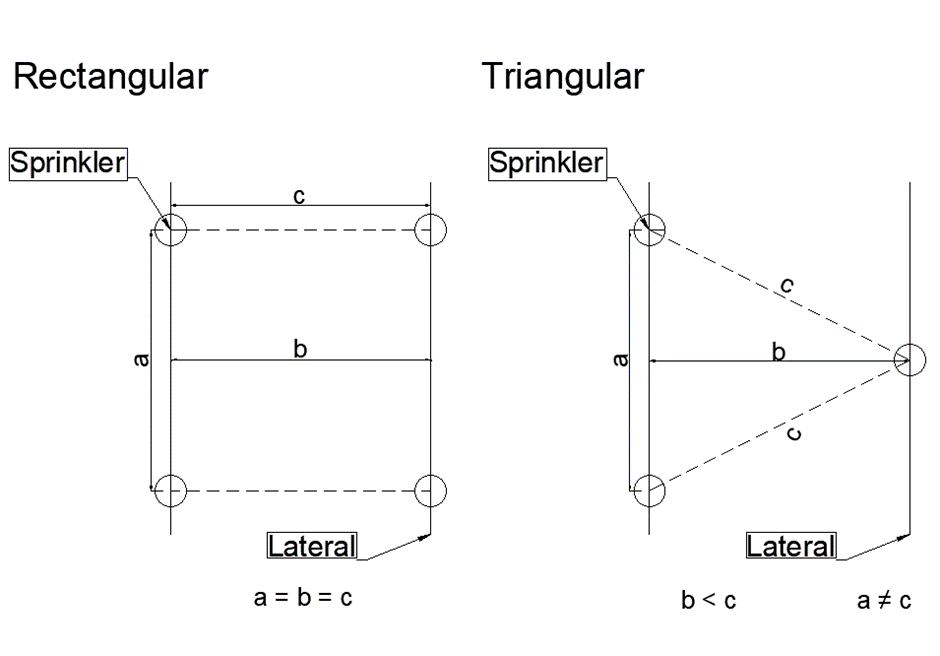- Last updated May 03, 2022
- Agricultural Irrigation, Sprinkler Irrigation
Sprinkler Irrigation - Terms and Concepts
To select the appropriate sprinkler system, we must be familiar with the following terms and concepts:
A. Precipitation rate (Pr)
B. Water distribution uniformity
• Christiansen coefficient of uniformity (%CU)
• Distribution uniformity (%DU)
• Scheduling coefficient (SC)
C. Evaporation loss during sprinkler irrigation
D. Soil infiltration rate
E. Maximum length of lateral
F. Head loss in the riser tube
G. Sprinkler water trajectory
A. Precipitation rate (Pr)
The average amount of water applied to the irrigated area during a specified period is measured in mm/h (millimetres per hour) units.
| Pr (mm/h) = Sprinkler flow rate (l/h) / [Spacing between sprinklers in the same row (m) x Spacing between rows (m)] |
E.g. Sprinkler flow rate= 600 l/h
Spacing between sprinklers on the same row= 10 m
Spacing between rows= 10 m
Pr = 600/(10 x 10)= 6mm/h
| Pr= 6mm/h |
B. Water distribution uniformity
It is a measure of how much water is applied evenly over the irrigated area. Properly designed sprinklers enable greater distribution uniformity. Good supply uniformity gives a high-quality yield.
There are 3 methods for calculating distribution uniformity:
- Christiansen coefficient of uniformity (%CU)
- Distribution uniformity (%DU
- Scheduling coefficient (SC)
Christiansen coefficient of uniformity (%CU)
% CU is the measure of uniformity expressed as the average rate (%) of deviation from the overall average application.
For open field sprinkler irrigation, %CU of:
- 92% or higher- Excellent uniformity
- 88% to 92%- Very good uniformity
- 86% to 88%- Good uniformity
- Lower than 86%- Acceptable for certain low-value crops only
Distribution Uniformity (%DU)
% DU is a measure of uniformity, with the dry 25% of the surveyed area as a percentage of the total average net application.
For open field sprinkler irrigation, %DU of:
- 90% or higher- Excellent uniformity
- 80% to 90%- Very good uniformity
- 75% to 80%- Good uniformity
- Lower than 75%- Acceptable for certain low-value crops only
Scheduling coefficient (SC)
The scheduling coefficient is a run-time multiple. This is the time when one has to irrigate excessively in the driest part of the irrigated area to achieve the average application rate of the whole area.
For open field sprinkler irrigation, SC:
- Up to 1.1- Excellent uniformity
- 1.1 to 1.2- Very good uniformity
- 1.3 to 1.4- Good uniformity
- Higher than 1.4- Acceptable for certain low-value crops only
C. Sprinkler spacing pattern
It is important to achieve the best possible water supply uniformity with any given sprinkler plan an adequate sprinkler spacing pattern.

D. Evaporation loss during sprinkler irrigation
During sprinkler operation, some of the water evaporates as the droplets are sprayed through the air.
Evaporation loss depends on the following factors:
- Relative humidity (RH)
- Air temperature
- Nozzle size
- Working pressure
- Wind speed
Evaporative loss from sprinklers can be reduced by changing sprinkler operating conditions to increase water droplet size or by operating the system under conditions of low climatic demands (high RH, low air temperature, and low wind speed).
E. Soil infiltration rate
Infiltration is the process by which water at the soil surface enters the soil. In soil science, the infiltration rate is the rate at which the soil can absorb rain or irrigation. It is measured in millimetres per hour or inches per hour. The rate decreases as the soil become saturated. If the rate of precipitation exceeds the rate of infiltration, the runoff will generally occur unless some physical barrier is in place. This is related to the saturated hydraulic conductivity of the soil near the surface. The infiltration rate can be measured using an Infiltrometer. In general, the soil is made up of three components: sand, silt, and clay. The relative amounts of these components affect soil texture, which influences the rate at which water can infiltrate the soil.
F. The maximum length of lateral
When planning an irrigation system (drippers or sprinklers), it is of the utmost importance not to exceed the maximum possible length of the laterals to avoid a severe reduction in irrigation uniformity and therefore efficiency, resulting in less performance.
Factors depend on the maximum possible length of laterals:
• Emitter flow rate
• Inside diameter of the lateral (ID)
• Internal texture (roughness) of the lateral (C)
• Distance between emitters on the lateral
• Topographic slope of the lateral
• Pressure at the inlet of the lateral
G. Head loss in the riser tube
The head loss in the riser tube is defined by 2 factors:
1. Factors depend on the maximum possible length of laterals:
• The flow rate
• The inside diameter (ID) of the riser tube
• The length of the riser tube
• The internal texture (roughness) of the riser tube (C)
2. Elevation loss
The elevation loss depends on the elevation of the sprinkler above the lateral (1 metre= 0.1 bar).